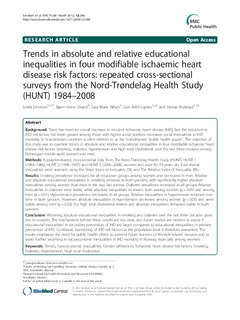Trends in absolute and relative educational inequalities in four modifiable ischaemic heart disease risk factors: repeated cross-sectional surveys from the Nord-Trondelag Health Study (HUNT) 1984-2008
Journal article, Peer reviewed
Permanent lenke
http://hdl.handle.net/11250/1237818Utgivelsesdato
2012Metadata
Vis full innførselSamlinger
Sammendrag
Background: There has been an overall decrease in incident ischaemic heart disease (IHD), but the reduction in
IHD risk factors has been greater among those with higher social position. Increased social inequalities in IHD
mortality in Scandinavian countries is often referred to as the Scandinavian “public health puzzle”. The objective of
this study was to examine trends in absolute and relative educational inequalities in four modifiable ischaemic heart
disease risk factors (smoking, diabetes, hypertension and high total cholesterol) over the last three decades among
Norwegian middle-aged women and men.
Methods: Population-based, cross-sectional data from The Nord-Trøndelag Health Study (HUNT): HUNT 1
(1984–1986), HUNT 2 (1995–1997) and HUNT 3 (2006–2008), women and men 40–59 years old. Educational
inequalities were assessed using the Slope Index of Inequality (SII) and The Relative Index of Inequality (RII).
Results: Smoking prevalence increased for all education groups among women and decreased in men. Relative
and absolute educational inequalities in smoking widened in both genders, with significantly higher absolute
inequalities among women than men in the two last surveys. Diabetes prevalence increased in all groups. Relative
inequalities in diabetes were stable, while absolute inequalities increased both among women (p = 0.05) and among
men (p = 0.01). Hypertension prevalence decreased in all groups. Relative inequalities in hypertension widened over
time in both genders. However, absolute inequalities in hypertension decreased among women (p = 0.05) and were
stable among men (p = 0.33). For high total cholesterol relative and absolute inequalities remained stable in both
genders.
Conclusion: Widening absolute educational inequalities in smoking and diabetes over the last three decades gives
rise to concern. The mechanisms behind these results are less clear, and future studies are needed to assess if
educational inequalities in secondary prevention of IHD are larger compared to educational inequalities in primary
prevention of IHD. Continued monitoring of IHD risk factors at the population level is therefore warranted. The
results emphasise the need for public health efforts to prevent future burdens of life-style-related diseases and to
avoid further widening in socioeconomic inequalities in IHD mortality in Norway, especially among women.
